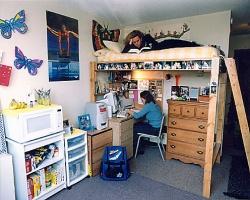Colleges experiencing larger-than-expected freshman enrollments are scrambling to relieve overcrowding in dorms, classrooms, cafeterias and elsewhere. Winston-Salem State University in North Carolina closed its freshman admissions in July and asked faculty to teach extra courses after projecting the freshman class would break its 2005 record of 1,083 by hundreds. Marist College in Poughkeepsie, N.Y., which expects to enroll 89 more freshmen than its target of 950, gave laptops or a $1,000 tuition break to 168 students who agreed to live three to a room instead of two.
An overall increase in freshmen was expected, in part because the number of high school graduates rose this year. Also, lower-tuition public institutions traditionally attract more students during a weak economy. Yet the huge spikes some colleges are reporting as classes begin suggest how hard it is “to hit the nail right on the head” when planning for enrollments, says Barmak Nassirian of the American Association of Collegiate Registrars and Admissions Officers. He is tracking enrollment patterns at the group’s 2,000 member colleges. Schools typically set enrollment goals years in advance, then adjust as the admissions cycle runs its course.




